-
Key Takeaways
-
Choosing the Right Drone
- Types of Drones
-
Essential Drone Equipment
- Remote Controller (Radio Transmitter)
- Spare Batteries
- Charger
- Spare Propellers
- Memory Cards
-
Safety Gear for Drone Operators
- Compliance with Regulations
- First-Aid Kit
- Personal Protective Equipment (PPE)
- Fire Safety Equipment
-
Accessories to Improve Your Drone Flying Experience
- Landing Pad
- Carrying Case or Backpack
- ND Filters
- External Monitor
- GPS Tracker
- Multi-Tool for Repairs
-
Drone Pre-Flight Planning Tools
- Weather Apps
- Flight Planning Apps
-
Drone Maintenance and Care Equipment
- Cleaning Kit
- Checklist
- Protective Gear for Drones
- Drone Repair Kit
-
Drone Insurance
-
Conclusion
Murphy’s Law states that “anything that can go wrong, will go wrong”. This rings true every day when dealing with drones and the equipment that goes with them.
Ever arrived at the perfect flying spot you’ve been dreaming about? Then your heart sinks. Your batteries are dead, your controller won’t connect, or your SD card fails.
This guide covers everything from choosing the right drone and essential gear to PPE (Protective Personal Equipment), useful accessories, and tips for maintenance and compliance with federal, state, and local regulations.
Heads up: Some links in this article are affiliate links. As an Amazon Associate, we earn from qualifying purchases. This helps support the site so we can keep creating content for readers like you.
Key Takeaways
- Choose your drone based on your flying purpose, experience level, and budget.
- Stock up on gear like batteries, propellers, frames, ND filters, etc, they will need to be replaced eventually!
- Use safety equipment to comply with FAA regulations, including Remote ID and airspace maps.
- Accessories such as ND filters, landing pads, and GPS trackers can improve both operational safety and quality.
Choosing the Right Drone
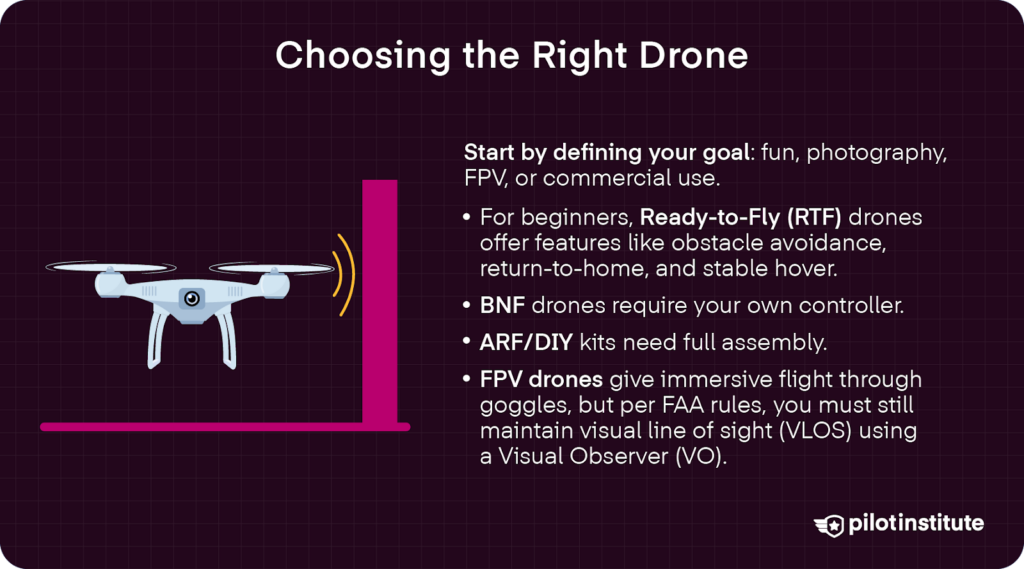
Determine your primary use for the drone—is it just for fun, aerial photography/videography, FPV (First-Person View) racing, agriculture, public safety, or commercial work?
Most photography-centered drones, such as the DJI Mini 4 Pro, are packed with great features like altitude hold, obstacle avoidance, return-to-home, and auto-hover, which can be very helpful when getting started.
Types of Drones
Ready-to-Fly (RTF) Drones:
These drones come fully assembled and include everything needed to start flying out of the box (drone, controller, battery, headset, etc.). RTF models are ideal for beginners or anyone who wants a hassle-free setup.
Bind-and-Fly (BNF) Drones:
BNF drones come pre-assembled, but without a controller or headset (typically). They are geared towards pilots who may already own a compatible radio transmitter or who want to choose their own controller.
Almost Ready-to-Fly (ARF) / DIY Drones
ARF are unassembled kits, consisting of components required to assemble the entire aircraft.
First-Person View (FPV) Drones
FPV drones are commonly used for racing, cinematography, and promotional footage. FPV pilots use goggles that put them in the “cockpit” of the drone, offering an immersive experience that’s hard to find elsewhere.
According to the FAA, when flying FPV, you are still required to maintain VLOS (Visual Line of Sight) with your aircraft through a VO (Visual Observer).
Essential Drone Equipment
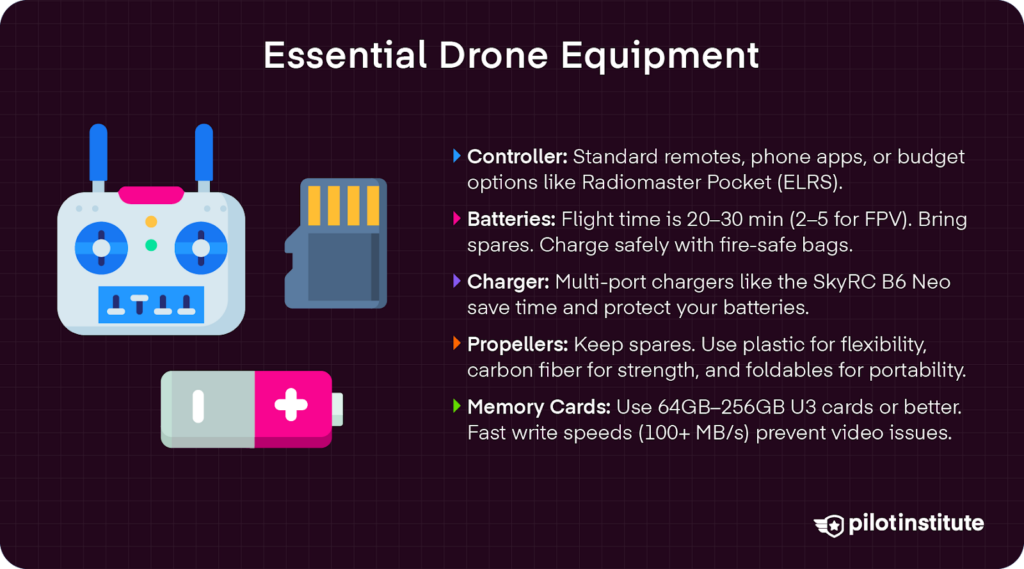
Remote Controller (Radio Transmitter)
The following are some common controller, or transmitter, types:
- Standard Controllers: Traditional handheld units with dual joysticks and auxiliary buttons. These often operate on dedicated radio frequencies and offer a good range with fine-tunable control.
- Touchscreen: Some compact drones allow you to use a smartphone or tablet (with an app) as the controller.
- Advanced Transmitters: High-end or hobby-grade transmitters (often used for custom builds or FPV drones) can be bound to many different receivers.
Our recommendation for a “cheap transmitter” would have to be the Radiomaster Pocket. It runs the ExpressLRS (ELRS) protocol, an open-source protocol quite common in the FPV industry, and it still delivers a large number of programmable switches at a low cost.
Spare Batteries
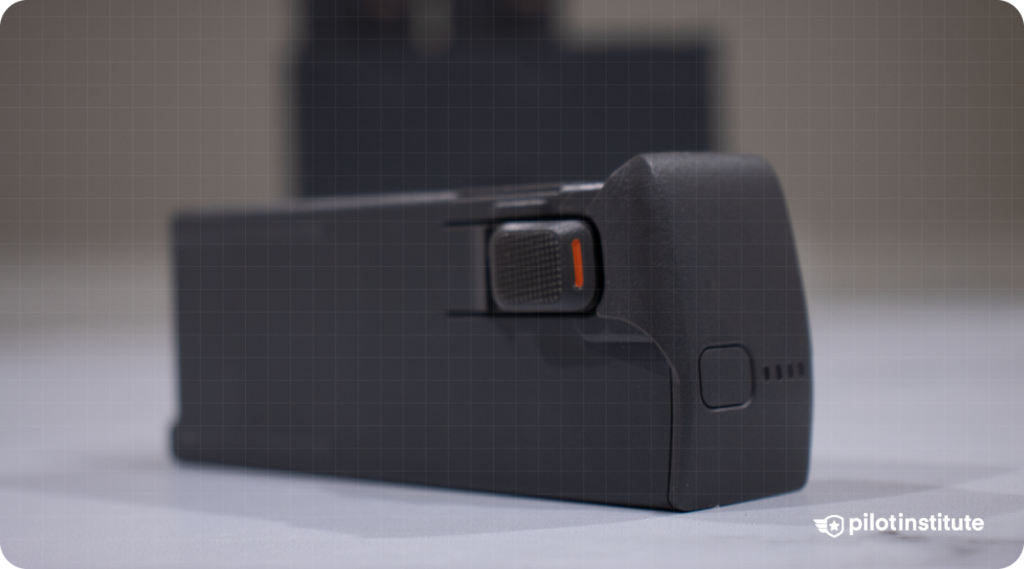
Extended Flight Time
While flight times vary, many beginner and prosumer drones offer a battery life between 20 and 30 minutes per charge.
Typically, small FPV drones will have a battery life of 2-5 minutes. That leaves little time for error, unless you have multiple batteries on hand. We will always recommend you bring more batteries than you think you’ll need, or a power source to recharge your spent ones!
Battery Safety
Treat lithium batteries as a hazardous, highly flammable material. You should never leave these batteries charging unattended, and always use a fire-safe bag when storing them.
Charger
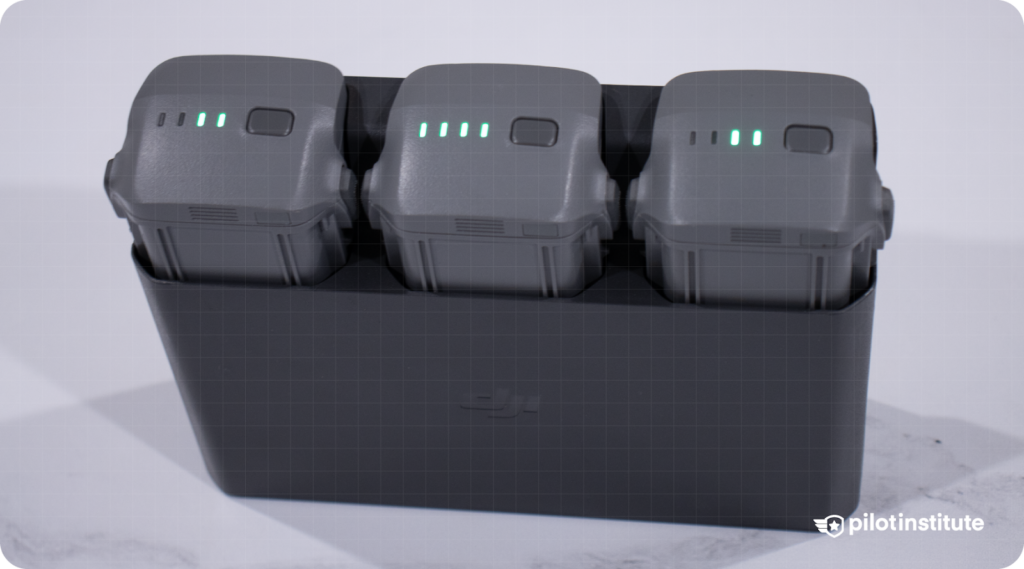
Multi-Battery Chargers
If you have several batteries, you should consider investing in a multi-port charger or a charging hub that can charge multiple packs sequentially or simultaneously.
As a general charger that can be used with most drone batteries, we highly recommend the SkyRC B6 Neo(paid link). It is a compact charger, capable of balancing charging, putting batteries into storage mode, and letting you fine-tune the voltage you want to charge or discharge to.
Charging Safety Tips
You should always use a charger that is appropriate for your battery’s type and voltage. Overcharging Lithium batteries can be dangerous, so your charger should automatically stop at the proper voltage. Never leave batteries charging unattended.
Spare Propellers
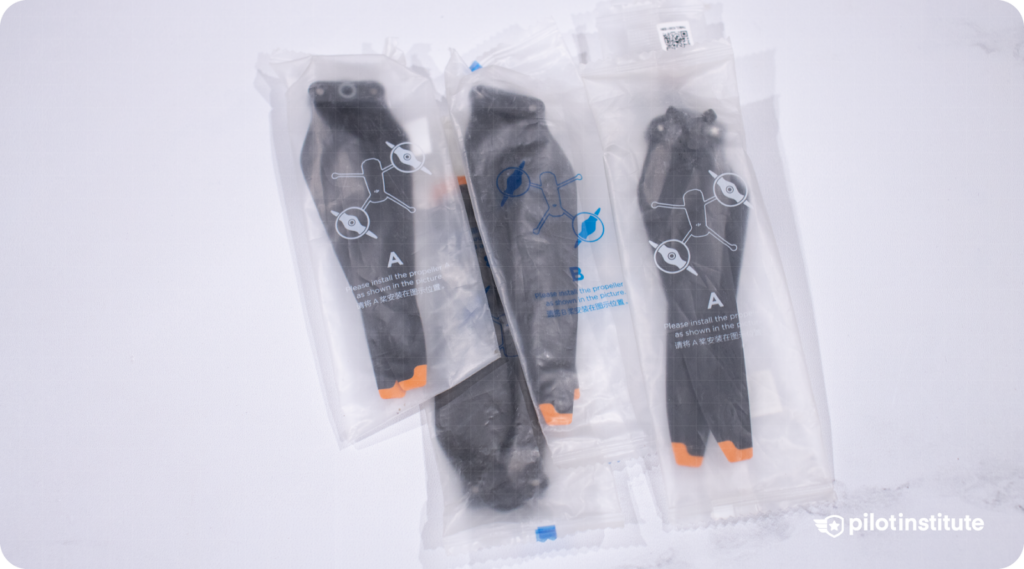
Importance of Spares
It’s very common to chip, crack, or completely break a propeller. Even a hairline fracture in a blade can have catastrophic consequences.
Before each flight, inspect your propellers for any signs of damage (nicks, cracks, dings, warping). Even a slight imbalance can affect performance or lead to vibration in your footage.
Types of Propellers
Plastic Propellers
The standard on most drones, plastic props are inexpensive and somewhat flexible. Their flexibility can be forgiving (they might bend rather than break on minor impacts), which is good for beginners.
Always use the correct size and pitch prop that the drone manufacturer specifies.
Carbon Fiber Propellers
Carbon fiber propellers are commonly found as aftermarket parts. They’re more rigid and lighter, but it comes at a cost.
Their rigidity means the momentum during a wreck will be transferred directly to the electronics or frame, which spells trouble for your wallet.
Foldable Propellers
Many modern camera drones will have foldable propellers. Instead of the unibody propellers found on many FPV aircraft, these foldable propellers attach as two separate pieces, allowing each blade to have a larger range of motion.
Memory Cards
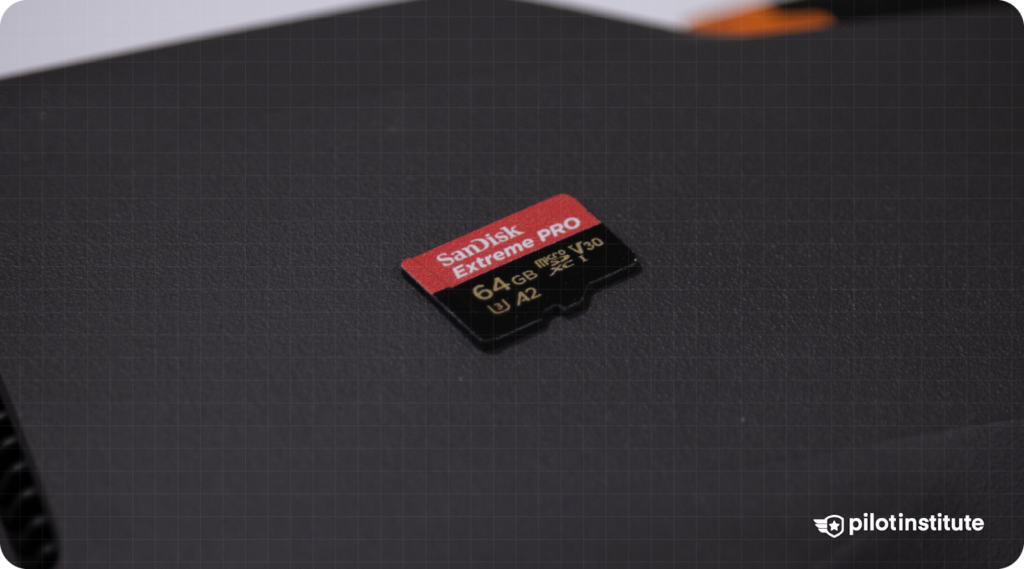
Storage Capacity
High-resolution photos and videos eat up a lot of memory. It’s common to use 32GB, 64GB, 128GB, or 256GB microSD cards with drones.
What We Recommend
Check for the required speed class (V30/U3), UHS-I support, and max supported capacity in your manual for your drone.
Affiliate disclosure: As an Amazon Associate I earn from qualifying purchases.
- SanDisk Extreme microSDXC (V30, A2) 256GB – (paid link)
- SanDisk Extreme Pro microSDXC (V30, A2) 512GB – (paid link)
- Samsung PRO Plus microSDXC (V30, A2) 512GB – (paid link)
- Lexar Professional 1066x (Silver Series) microSD (V30, A2) 256GB – (paid link)
- Kingston Canvas Go! Plus microSD (V30, A2) 512GB – (paid link)
- SanDisk High Endurance microSD (V30) 512GB – (paid link)
- PNY Elite-X microSD (V30) 256GB – (paid link)
A 4K video can consume several gigabytes for just a few minutes of footage. Using a high-capacity card ensures you don’t run out of space mid-flight.
Speed Class
A card’s write speed is its ability to take the data it’s given, and move that data to its internal memory. If your memory card cannot write data as quickly as it receives data, your video file could drop frames, or be corrupted.
For drones shooting 4K or high-bitrate video, you should use cards with a fast write speed to prevent dropped frames or corrupted files. A card labeled UHS Speed Class 3 (U3), which guarantees a minimum write speed of 30 MB/s, is a good starting point. However, for greater reliability, sources recommend choosing a card with a write speed of at least 100 MB/s
Safety Gear for Drone Operators
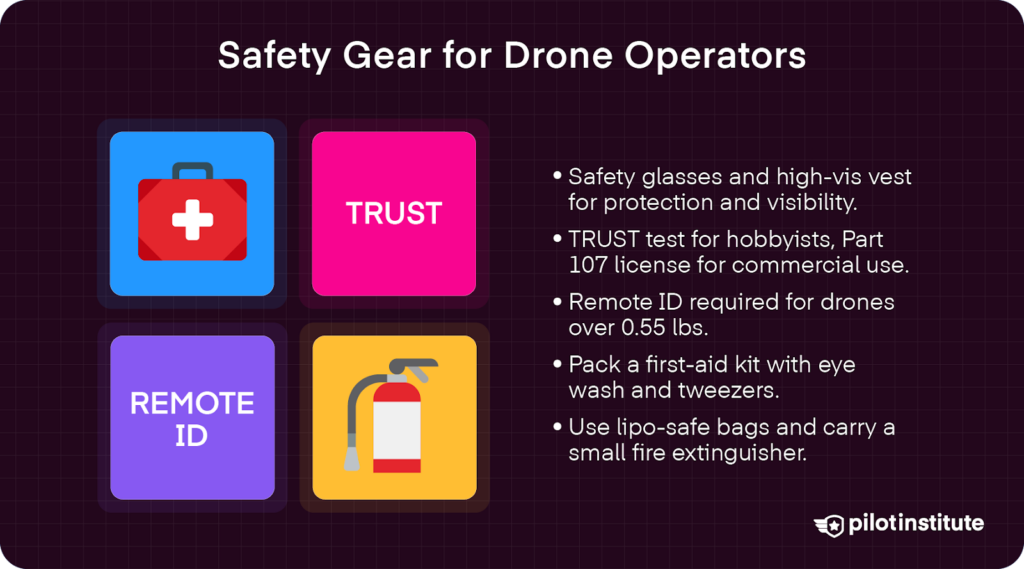
Compliance with Regulations
Remote ID Requirements
As of recent FAA rules, drones in the United States that are required to be registered (weighing 0.55 lbs or more, used recreationally or under Part 107) must have Remote ID capability.
We recommend reading up on Remote ID regulations.
Certification
If you are flying just for fun (recreationally), you should take the FAA’s free safety test called TRUST (The Recreational UAS Safety Test). That way, you at least know the basics of drone operation before flying in our airspace.
A TRUST certificate is easy to obtain online, and you should carry the completion certificate (digital or printed) with you at all times when operating. For commercial flying (anything where you are being paid or the flight aids a business in any way financially), you need to hold a Part 107 Remote Pilot Certificate.
First-Aid Kit
Drone operations usually are low-risk, but you are often outdoors and sometimes in rough environments. A first-aid kit could help with:
- Minor Injuries: In case you trip, get a cut, or have a run-in with a thorn bush while retrieving a drone, you’ll want supplies to clean and bandage a wound. Stock bandages of various sizes, antiseptic wipes or spray, adhesive tape, and perhaps some gauze.
- Eye Wash and Tweezers: If dust or sand blows into your eyes (perhaps from rotor wash during takeoff/landing), a small eye wash solution can be a relief. Tweezers are handy for removing splinters or cactus spines (a known issue in some desert flying spots!).
- Emergency Info: You should keep important phone numbers in your kit. Put an emergency contact and any relevant medical information (if you have allergies or conditions) on a card, and always keep it in there.
Drone flying isn’t necessarily dangerous, but being prepared is part of being a responsible operator.
Personal Protective Equipment (PPE)
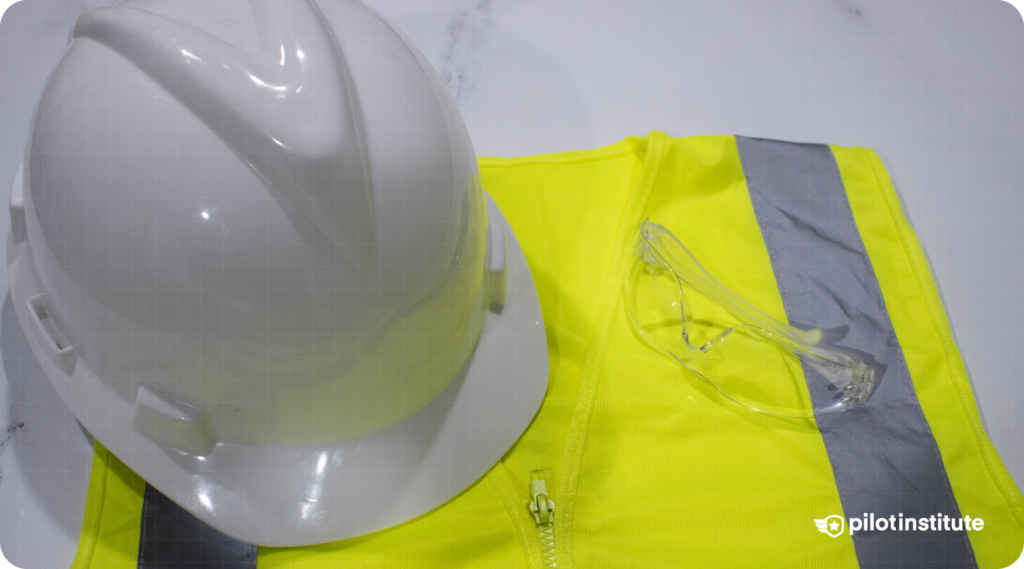
Safety Glasses
It’s a good practice to wear safety glasses, especially during takeoff and landing. Small drones can kick up dust or debris, and in the event of a crash or propeller strike, your eyes will be protected.
High-Visibility Vest
If you operate in public areas, a high-vis vest can help bystanders identify you as the drone operator. This can prevent awkward situations where someone might not realize you’re controlling a nearby drone.
Gloves and Protective Clothing
If you’re flying in cold weather, thin gloves that still allow you to feel the controller sticks will keep your hands warm and nimble. Some gloves, made with removable fingertips, are great for operating drones or cameras outdoors.
Fire Safety Equipment
Fire Extinguisher
Even if you’re not in a dry area, you should carry a small fire extinguisher that’s rated for electrical fires (Class C) and flammable liquids (Class B).
A common choice is a compact ABC-rated extinguisher, which covers all types.
Battery Safe Bags
Lithium-safe bags have velcro and/or zipper closures to seal the battery inside, which is perfect when charging large Lithium batteries. In some cases, if you’re traveling by airplane with drone batteries, it would be highly advised to carry them in these bags.
The bags are relatively inexpensive, and while hopefully you’ll never witness a battery fire, it’s better to have the protection just in case.
Accessories to Improve Your Drone Flying Experience
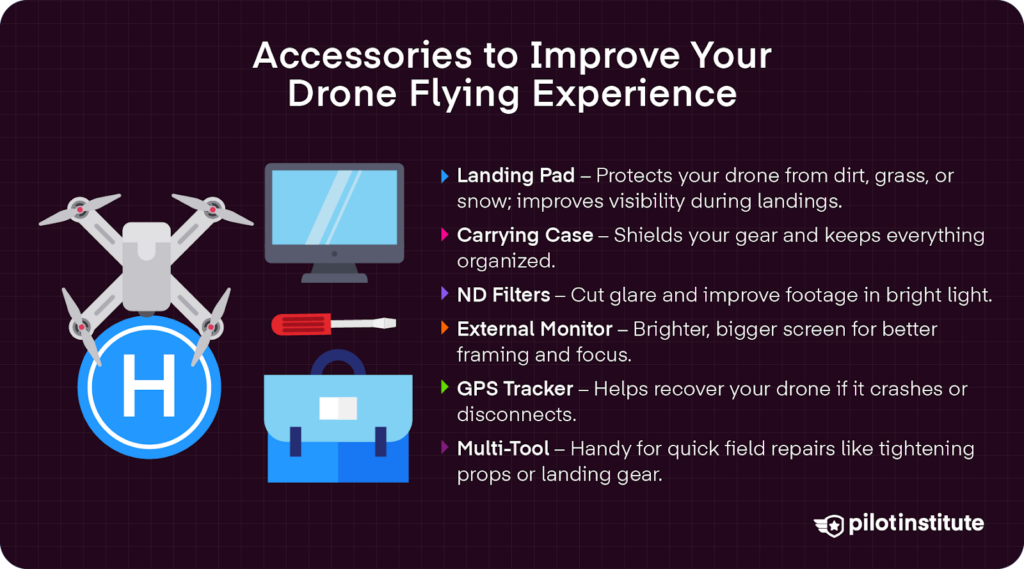
Landing Pad
Protect Your Drone
A landing pad provides a clean, flat surface that shields the drone from mud, tall grass, gravel, or snow. It’s especially useful for drones with low ground clearance or sensitive gimbals, as you avoid the camera scraping the ground or debris hitting the lens.
Visibility
Most landing pads are brightly colored (often orange with a white “H” or similar high-contrast pattern). This makes it much easier to spot your takeoff/landing spot from the air.
Features to Look For
Landing pads usually fold up for transport (some pop up like a twist-fold disc, others are foldable fabric with stakes). Look for a pad that is durable and waterproof, since it will be outdoors on dirt or mud.
Many come with weighted edges or ground stakes, which is important because the prop wash from larger drones can blow a lightweight pad away.
Carrying Case or Backpack
Protection During Transport
A dedicated case prevents your drone from rattling around, and protects fragile parts (like the camera and propellers) from being crushed.
Many cases are waterproof or at least water-resistant, which is a big plus if you get caught in rain or set the bag down on the wet ground.
Organization
Drone cases often have custom foam inserts or compartments to fit the drone and specific accessories. This means every battery, controller, cable, and spare part has its place.
Choosing the Right Case
The ideal case or backpack depends on your drone size and how much gear you carry. While we might prefer using a generic outdoor backpack to carry our gear, there are plenty of brands that specialize in drone and camera gear for storage.
ND Filters
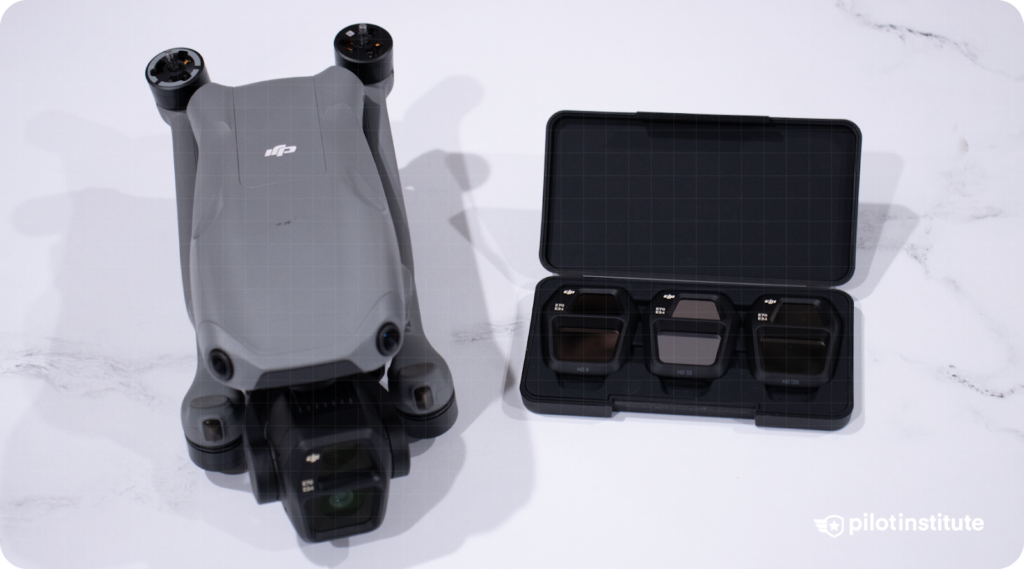
Neutral Density (ND) filters are like sunglasses for your drone’s camera. They reduce the amount of light entering the lens, which can dramatically improve your photos and videos in bright conditions.
Enhance Image Quality
ND filters solve over-exposed, choppy footage by cutting light, allowing you to use slower shutter speeds without blowing out the image. The result is smoother, more cinematic footage with a natural motion blur.
Types and Uses
ND filters are numbered by how much light they block. Common sets for drones include ND4, ND8, ND16, ND32, and ND64. The higher the number, the darker the filter (more light reduction).
A great time to utilize ND64 and up would be in snowy landscapes, where the bright light is reflecting off the snow into your drone’s lens.
External Monitor
Improved Visibility
A dedicated external monitor often has higher brightness and anti-reflective coatings, with the bonus of not having to use your main form of communication as a screen.
Larger Display
A bigger screen or monitor means you can see finer details. This helps for manual focus adjustments (if your drone allows that), checking exposure and composition, and spotting any issues in the shot.
Enhanced Control
Using an external monitor gives you a clearer (hopefully) larger view of the video feed, especially in bright environments where your phone or tablet’s screen can be hard to see.
When you’re shopping for a monitor, you want to make sure it’s bright enough before dropping a lot of money. A monitor with at least 1,000 “nits” is a good place to start.
GPS Tracker
Recover Lost Drones
An onboard GPS is usually doing one of two things – it’s either telling the drone its own location, or it’s acting as a beacon by letting other devices know its location.
Types of Trackers
There are a couple of common types. Standalone GPS devices have their own GPS receiver and usually a cellular SIM card; they can send real-time location updates to an app or website.
Choosing a Tracker
For expensive drones, a standalone GPS tracker might be worth the investment for the coverage and precision. Just be mindful of weight; a heavy tracker could affect a small drone’s performance in a huge way.
Multi-Tool for Repairs
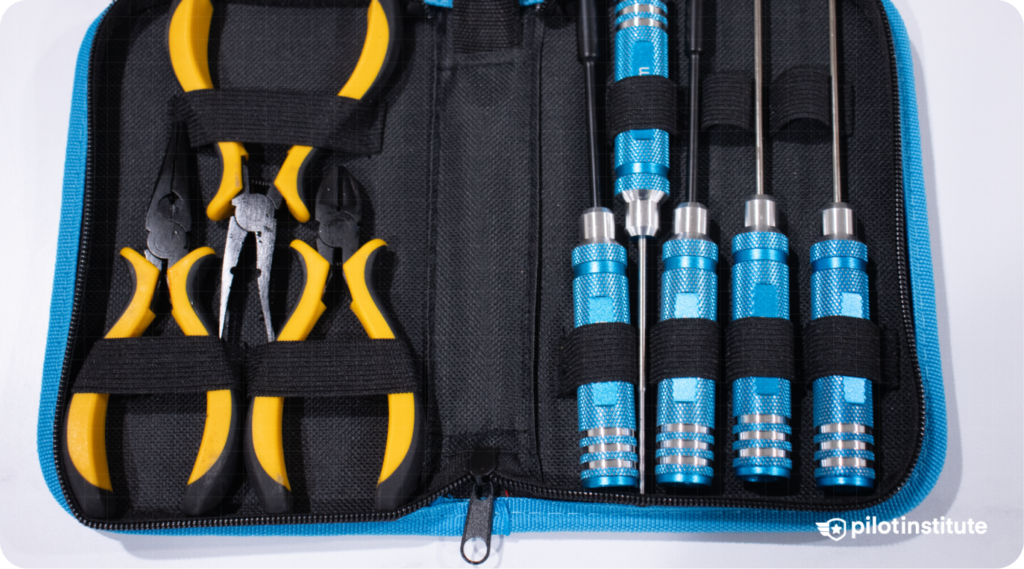
On-the-Spot Fixes
Suppose you notice a rotor arm is a bit wobbly, or a prop screw is barely holding on, or a landing gear screw is missing. What are you supposed to do in a pinch? Do you just give up and call it a day, or do you sit down and take the time to repair?
Having tools on hand means you can fix these issues and continue flying, rather than packing up and going home.
Essential Tools
A set of hex wrenches is often needed for custom or racing drones. Small pliers or wire cutters can help straighten bent parts or cut zip-ties. Tweezers are great for picking up tiny screws or putting small wires in the right spot.
Ultimately, your specific needs will determine what tools you decide to bring. Ask yourself what it is you need, and write it down before your next outing. It never hurts to plan ahead!
Drone Pre-Flight Planning Tools
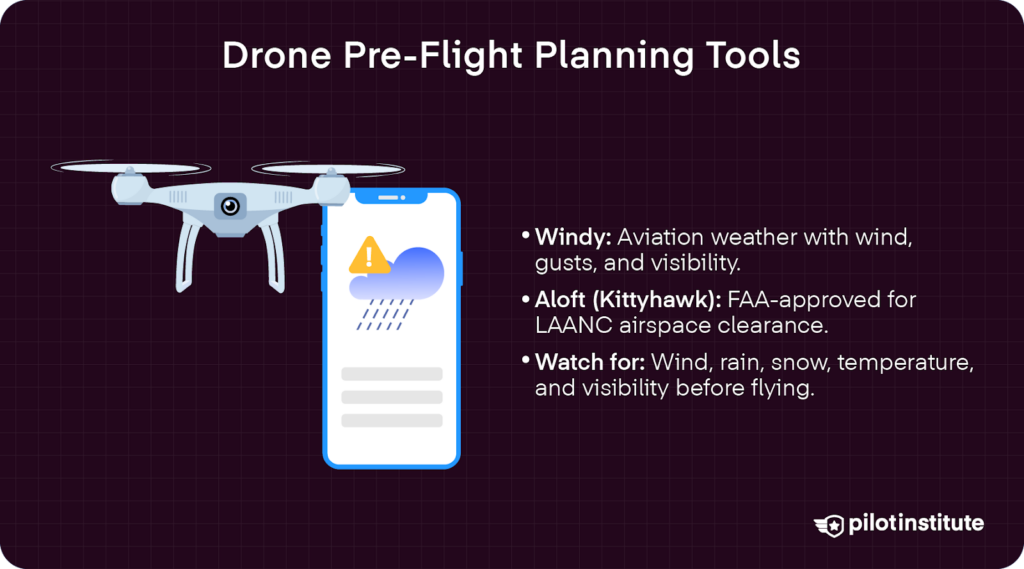
Weather Apps
Safety First
Standard weather apps (like Weather.com, AccuWeather, or even the generic app you may find on your phone) are a start, but they may not focus on the stuff that matters most to drone operations. Consider using apps like Windy, which is tailored to aviators of all kinds.
Things to Watch
As a drone pilot, key weather factors to watch are: wind speed and gusts (drones have trouble in high winds, especially smaller ones), precipitation (don’t fly in rain or snow unless your drone is rated for it, which most are not), temperature and visibility.
Flight Planning Apps
Airspace Awareness
Apps like AirHub and Aloft Air Control (formerly Kittyhawk) provide interactive maps showing your location relative to controlled airspace, airports, national parks, and other restricted areas.
Clearance is usually granted through a LAANC (Low Altitude Authorization and Notification Capability) request , and there are a few apps that have been approved by the FAA for official use.
Drone Maintenance and Care Equipment
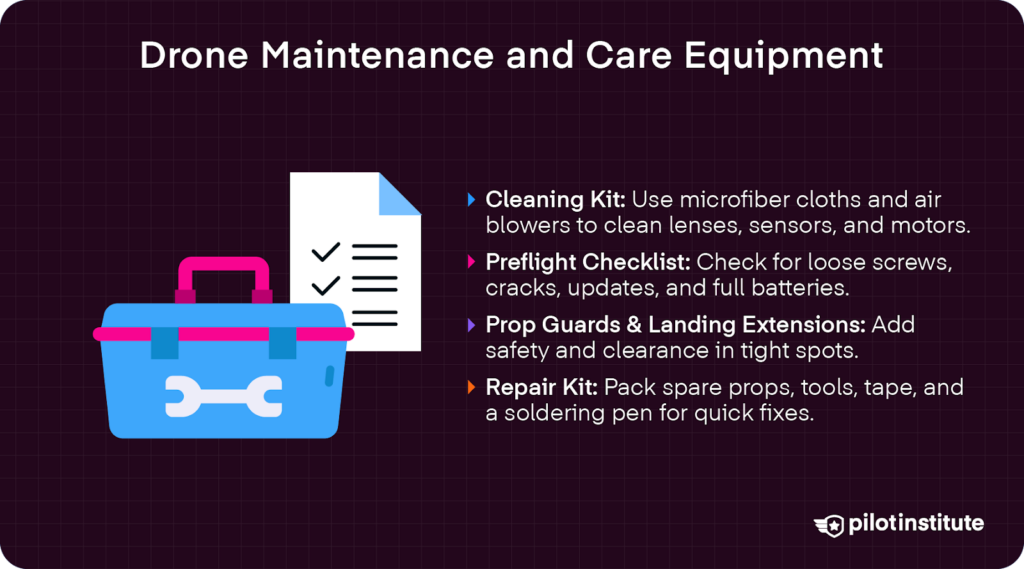
Cleaning Kit
Lens and Sensor Care
Keep your drone’s camera lens and sensors clean to ensure sharp, high-quality footage.
Use microfiber cloths, lens cleaning solution, and air blowers to safely remove dust and smudges.
Regular Maintenance
An easy way to extend your drone’s lifespan is as easy as cleaning motors, arms, and propellers after every few flights. Before each flight, it’s advised to check everything over again as well.
Checklist
Before each flight, you should have a checklist you refer to. In that list, you want to have the following items, in addition to your own steps:
- Loose screws or components.
- Cracked arms or propellers.
- Firmware or app updates needed.
- Batteries charged.
Protective Gear for Drones
When operating near people, or in urban environments, prop guards are a great safety tool to have on hand.
Landing gear extensions can provide your aircraft the extra few inches of clearance to get your sensor up above foreign objects, debris, etc.
If you want to customize your drone while adding a layer of protection, it may be worth it to look into decals. There are thousands of options out there for hundreds of different drone airframes, and we challenge you to check out a few next time you’re looking to add some new equipment to your kit.
Drone Repair Kit
Small Repair Kit
Include essentials like extra propellers, zip ties, electrical tape, soldering tools, small screwdrivers, and quick-setting glue.
A portable soldering iron is extremely useful if you fly FPV or work with custom rigs. Out in the field, a battery-powered soldering pen, like the Pinecil V2(paid link), can reattach a broken motor wire or fix a damaged connector.
Drone Insurance
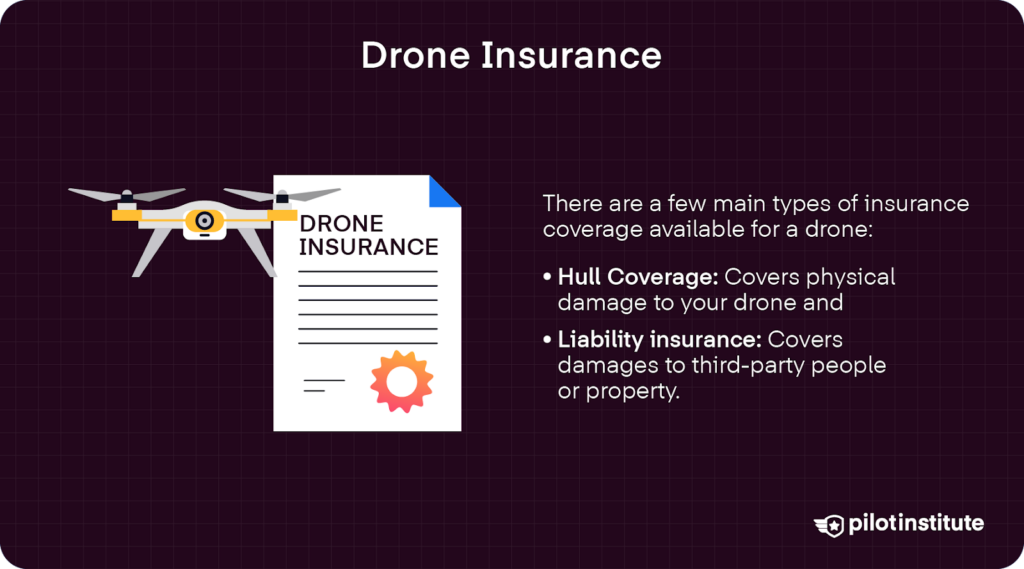
Protect Your Investment
Drones are an investment, and just like you’d insure a car or camera gear, you might want to insure your drone, especially if you use it for business or fly expensive equipment.
Types of Coverage
There are a few main types of insurance coverage available for a drone:
- Hull Coverage: Covers physical damage to your drone and
- Liability insurance: Covers damages to third-party people or property.
Conclusion
Equipping yourself with the right drone gear is an essential part of being a prepared and responsible pilot. From the drone itself (chosen to match your needs and skills) to the myriad of accessories and safety equipment, each piece of gear contributes to a smoother, safer flying experience.
Fly safe and have fun! Before your next flight, take stock of your gear using this article as a guide. Maybe there are a few items you don’t have yet that could really enhance your setup. Consider giving them a try.
And as always, prioritize safety and respect for the rules of the sky. With the right gear and mindset, you’ll be set to earn your wings as a top-notch drone pilot on every flight.



